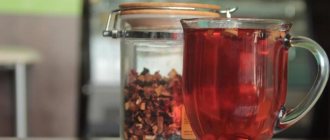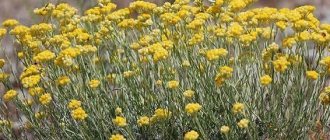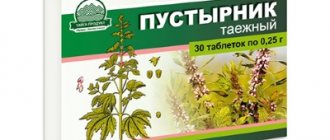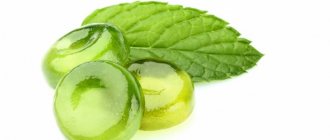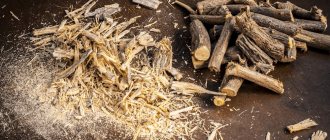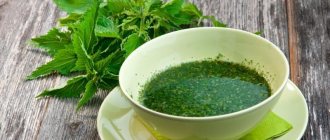Rhodiola rosea (pink, golden root) is a herbaceous perennial plant from the Crassulaceae family. It has a distinctive feature: the root and rhizomes are the color of bronze or old gilding with a noticeable pearlescent sheen, due to which it received its second “precious” name. The plant is included in the Red Book of the Russian Federation.
It is found in regions with temperate and cold climates, including Great Britain, North America and Ireland, grows well in alpine mountain meadows (in the Pyrenees, Alps, Carpathians), found in Kazakhstan, grown in China, Bulgaria, India. In the Russian Federation it is found in Altai and the Urals, in the mountainous regions of the Far East, Eastern and Western Siberia, in the polar regions of Yakutia, on the coasts of the Barents and White Seas. The plant is undemanding to light and heat, but needs plenty of moisture. It grows on rocks and rocky outcrops, in flat tundra, on the banks of mountain rivers and streams.
It has long been used in folk and official medicine as an effective adaptogen that increases resistance to adverse environmental factors, as well as a stimulant of the central nervous system. Part of the group of adaptogens, it combines and competes with eleutherococcus and ginseng.
Morphological description
The rhizome is horizontal, powerful, covered with a brown (bronze) cork, and has thin adventitious roots. When broken, the root is white, has a bitter-astringent taste, and has a special aroma, similar to the smell of a rose.
Most often, the plant has several (10-15 pieces) non-branched erect stems, 10-40 cm high, less often there is only one stem. The leaves are alternate, sit on stems, have an oblong-ovate, elliptical or pointed shape with a whole or serrate-toothed upper part.
Flowering occurs in June-July, fruits reach maturity in July-August. The inflorescence is multi-flowered and has a corymbose shape. The flowers are yellow, unisexual, four-, less often five-membered. The fruits are erect, multi-leafed, green.
Propagated both by seeds and vegetatively.
A modest flower with a precious rhizome
The medicinal properties and contraindications of golden root are mentioned in ancient manuscripts. The raw materials were used by traditional healers who lived in Asian countries. Perhaps merchants brought it there and sold it at a very high price.
Currently, the culture is found in the territory:
- Great Britain;
- North America;
- Ireland;
- in the Urals and Altai;
- Kazakhstan;
- Siberia.
It is actively grown in China, India, and Bulgaria to be used for medicinal purposes. The plant loves moist soil. In nature it grows on flat tundra, along the banks of rivers, lakes, on rocky slopes and cliffs. What does a golden root look like from the outside?
Another name for the perennial crop is Rhodiola rosea. It belongs to the Crassulaceae family. It is distinguished by erect stems that grow to a maximum of 40 cm in height. They are strewn with many sessile, alternate, lanceolate-shaped leaves. The upper part of the plate is framed by a jagged edge. In July, corymbose inflorescences are formed on the shoots, consisting of many unisexual buds of a yellow or greenish tint. However, the main pearl of the plant is its underground part. It consists of a powerful rhizome covered with a dense bronze-colored crust. The white pulp has a bitter taste and an aroma reminiscent of a rose.
The plant Rhodiola rosea (golden root) is listed in the Red Book of Russia.
Collection, preparation and reproduction
The root of Rhodiola rosea is harvested for future use (the plant is 3-4 years old). This is done between the end of July and September. The roots are dug up, thoroughly washed to remove soil particles in cool water, and cleaned of brown plugs and rotten, dry areas. Cut the rhizome into pieces, each 10 cm long, and dry them at 50 degrees in a dryer.
The finished raw material has a pinkish or white color when broken. If the root is brown in color at the break, it is unsuitable for use because it loses its beneficial properties. Store dry raw materials in canvas bags in a dark place. Shelf life – 3 years.
Most often, the plant is propagated by seeds: planted in late autumn or winter in a box with nutritious soil, providing good ventilation (expanded clay is placed on the bottom). The soil is pre-moistened with a weak solution of potassium permanganate and compacted a little. The seeds are evenly distributed over the surface and lightly pressed, covered with soil (2 mm layer), covered with film and placed on the balcony. In March, the box is moved to a warm, illuminated place, and within a couple of days shoots will appear. They can be replanted when two true leaves appear.
You can propagate a plant (which is at least 2 years old) by dividing the rhizomes into 2 parts, which are planted in prepared holes with humus; compost is also laid on top, leaving renewal buds on the surface.
Using Golden Root in folk medicine - complete instructions for use
The medical uses of Rhodiola rosea include its use in the following forms:
- Tincture with alcohol or vodka (the most effective remedy, since alcohol is the best at extracting their beneficial substances from any medicinal plant)
- Water infusion is also used quite often, but is not as effective. Mainly used for external use
- Golden Root Decoction - there are situations when the use of alcohol in preparing medicine is unacceptable! In this case, you can use a decoction of Rhodiola, which has proven itself quite well for a number of diseases, for example, gastrointestinal diseases, headaches, uterine bleeding, etc.
- Herbal infusions - in this case, not only Golden Root is used, but also other medicinal plants. There are a lot of such herbs and their use is justified by the fact that there are many plants that complement and enhance the healing effect of each other.
- Dietary supplements - there are many dietary supplements prepared based on the extract of this plant. You can find them in any pharmacy, but I will not consider them in this article, since they are much less effective than other forms of use. I recommend preparing the medicine yourself by purchasing whole, dry roots.
You can buy Golden Root for preparing tinctures, decoctions or water infusions in the Altaivita online store.
Tincture of golden root with vodka or alcohol
As I already said, tincture of Golden Root in alcohol is considered the most effective means of using this plant. This option is preferable to use if there are no contraindications. Preparing the alcohol tincture is very simple:
- Dry roots of Rhodiola rosea are taken in an amount of 50 grams, crushed to a powdery state (you can use a coffee grinder) or simply grated on a coarse grater, placed in a glass bottle (ideally made of dark glass) and filled with vodka (0.5 l.) or alcohol of no higher strength 70 degrees.
- The tincture is infused for exactly 2 weeks in any dark place at room temperature. It is advisable to shake it once every 2 days so that the healing substances of Rhodiola are better combined with alcohol.
- Take the tincture 15-20 drops, 3 times a day, half an hour before meals.
- The course of treatment is usually 25 days. If necessary, it is repeated after a 10-day break.
Important! The alcohol tincture must be taken in courses (20–25 days) with breaks between them (10 days). Otherwise, there is a risk of various side effects.
In addition, the last dose of the tincture should be no later than 4 hours before bedtime, otherwise sleep problems may occur.
For hypotension
If you suffer from low blood pressure, then it is correct to take the tincture starting from 5 drops, increasing their amount every 1-2 days by 1 drop, thereby bringing the amount to the recommended 20 by the end of the course.
To strengthen the immune system in the autumn-winter period
- To strengthen the immune system, Golden Root tincture is taken every day, 20 drops 3 times a day, 30 minutes before meals for three weeks.
- After 10 days, you can repeat the course of treatment.
To enhance mental and physical activity (suitable for students and schoolchildren taking the Unified State Exam)
If you feel chronic fatigue every day, you have an exam or other serious exams coming up, then the following recipe is suitable, which includes 3 courses of treatment one after the other.
Each course of treatment lasts 1 month, after which a break of 1 month is also required, so you need to calculate the timing of treatment in advance and start taking it somewhere 5-6 months before the exams.
Stage 1
- An alcohol tincture is prepared according to the recipe described above. Reception begins with 5 drops, increasing their number by 1 daily.
- Half a month after the start of treatment, that is, on the 15th day, the number of drops is reduced in inverse proportion, by the end of treatment reaching the same 5 drops with which the treatment began.
- Drops can be dissolved in a small amount of water or drunk without dissolving. After completing the 1st course, there is a mandatory break of 1 month.
Stage 2
- Alcohol tincture of the Golden Root is drunk 25 drops, without decreasing or increasing their quantity throughout the course.
- It is better to drink in the morning, on an empty stomach, once a day. The course is 30 days, then the same break.
Stage 3
- Drink the tincture once a day, in the morning, after meals, 25 drops. The course of treatment is 1 month.
It is no secret that for modern schoolchildren the Unified State Examination has become not just an exam, it is a great stress, which is very difficult to overcome without help. Those parents whose children took the Unified State Exam can confirm this. This recipe will help you cope with stress and get through a difficult period safely. By the way, taking the tincture will also be very useful for parents!
For cancer
Rhodiola tincture for oncology is taken before chemotherapy, as an adjuvant or simply for prevention, for those who are afraid of cancer.
- Before chemotherapy, treatment begins 1 week before with 20 drops, gradually increasing their number to 40 (drink every morning on an empty stomach).
- It is also possible, during a course of chemotherapy, to reduce its toxic effects on the body and increase the level of leukocytes in the blood. To do this, start taking it 5 days before the procedure.
- Take alcohol tincture 3 times a day before meals, diluting 30 drops in 50 ml of water.
For impotence
- For impotence, 2 courses of treatment are carried out, 3 weeks each with a break of 2 weeks between them.
- Dosage regimen: 5 drops 3 times a day 30 minutes before meals.
Water infusion of Golden Root
Water infusion of Rhodiola is mainly used for colds, heart and gastrointestinal diseases or for external use for various skin diseases, wounds, abscesses, etc. It is prepared simply:
- 20 grams of Rhodiola rosea roots need to be crushed in a coffee grinder or grated on a coarse grater and simply pour 2 cups of boiling water, leaving to steep for about 4 hours.
- Before taking, the infusion must be strained.
Reception regimen:
- 0.5 cup 3 times a day.
Decoction of Rhodiola rosea roots
The decoction has more effective properties than the infusion and is used for diseases of the thyroid gland, gastrointestinal tract, uterine bleeding, sore throat, headaches and toothaches, and also as an external application. It is prepared as follows:
- 20 grams of dry roots are crushed and poured with 0.5 liters of boiling water, then placed on the stove and simmered over low heat for another 10 minutes.
- Then, cover with a lid and leave to infuse until it cools completely.
Take 50 ml after straining. 3 times a day. Last dose no later than 4 hours before bedtime.
Important! This decoction is a powerful tonic! Much stronger than strong tea or ground coffee. Therefore, it is not recommended to take it for a long time or at night!
Herbal infusions with Rhodiola rosea
Herbal preparations in which Golden Root is just one of the components are also found quite often. There are different collections: to boost immunity, for colds, for diseases of the gastrointestinal tract, etc. By the way, it is best to restore immunity with the help of echinacea tincture.
As a rule, the herbs in them are selected in such a way as to have a comprehensive effect on any one problem and at the same time enhance and complement each other’s therapeutic effect.
You can purchase similar preparations with Rhodiola at a pharmacy, at your place of residence, or by ordering them online. If anyone is interested, ask in the comments, I’ll tell you where to stop and where to buy.
Chemical composition
The root of the plant contains more than 140 useful elements, which determine the complex positive effect.
- Phenols and their derivatives: tyrosol, salidroside. Strengthen the circulatory system, protect blood vessels from narrowing. Prevents cholesterol oxidation;
- Carbohydrates: glucose, fructose, sedoheptulose, sucrose. Participate in energy metabolism;
- Organic acids: oxalic (stimulates gastric secretion and intestinal function),
- apple (normalizes digestion, improves the condition of blood vessels, improves vision and is involved in metabolism),
- amber (neutralizes free radicals, reduces uric acid levels, restores joint mobility, stimulates insulin production),
- lemon (increases appetite, stimulates cell renewal, activates the immune system);
Straight chain aliphatic alcohols and monoterpene hydrocarbons were found in the essential oil. The composition of the essential oil varies depending on where the plant grows.
The aboveground part of the plant is saturated with organic acids (malic, citric, oxalic, succinic), phenols and their derivatives, phenolcarboxylic acids (gallic, caffeic), coumarins, tannins, and flavonoids.
Beneficial features
Golden root (rhodiola) is characterized by many beneficial properties:
- is a powerful antioxidant and adaptogen;
- protects the body from the development of cancer and prevents tumor metastasis;
- increases blood pressure;
- improves heart function;
- fights pathogenic microorganisms;
- has an anti-inflammatory effect;
- promotes bile secretion;
- stops bleeding;
- restores the body after overwork, tones well;
- has a general strengthening effect and increases the body’s resistance to the influence of unfavorable environmental factors;
- has a neuroprotective effect;
- stimulates the central nervous system;
- maintains the energy potential of the brain at a high level;
- improves cognitive functions;
- accelerates the course of oxidative processes;
- accelerates wound healing.
Scientific research
Scientific research began in the 60s of the 20th century. In 1961, an expedition led by G.V. Krylov was carried out, during which scientists managed to find the plant in the taiga of the Altai Mountains. Based on research results, the plant was introduced into scientific medicine and began to be used in the form of a liquid extract with adaptogenic and stimulating properties.
Numerous studies have been conducted to study the effect of the plant on the central nervous system. Plant preparations change the bioelectrical activity of the brain and improve cognitive functions: by increasing resistance to stress factors, memory and the ability to remember information improves.
The positive effect of plant preparations has been reported to eliminate the side effects of psychotropic therapy for schizophrenia.
A number of studies have shown that roseola rosea can improve physical performance. An experiment conducted on animals (white rats) recorded a decrease in the rate of glycolysis, the amount of lactic acid in the muscles, the preservation of a high level of phospholipids in the muscles and liver, as well as blood sugar after 2 hours of swimming in individuals receiving the plant preparation.
The possibility of using plant preparations as hepatoprotectors is also being considered. The effectiveness of use as a therapeutic and prophylactic agent for liver damage induced by organophosphorus compounds has been proven in animals.
Application
Rhodiola rosea is a powerful adaptogen that has a visible effect after the first use of the drug! But you can’t take plant preparations every day without reason. Constant stimulation of the body, even with herbal preparations, can lead to an effect opposite to the expected one.
Rhodiola is used for many diseases and pathological conditions, and is characterized by a whole range of pharmacological properties. The most common indications for the use of plant preparations:
- poor appetite;
- metabolic disorders;
- physical and mental fatigue;
- VSD;
- neuroses;
- asthenic condition after long-term illnesses;
- inflammatory processes;
- allergic reactions;
- radiation injuries (acute and chronic);
- reduced visual acuity;
- poor hearing;
- pulmonary tuberculosis;
- anemia;
- oncological diseases;
- bone fracture;
- menorrhagia;
- dysmenorrhea;
- amenorrhea primary and secondary;
- gynecological diseases (adnexitis, polycystic ovary syndrome, fibrocystic mastopathy);
- early menopause;
- impotence;
- oligospermia;
- late puberty;
- toothache;
- headache;
- gout;
- diabetes;
- conjunctivitis;
- angina;
- pyorrhea;
- diarrhea;
- wounds, skin lesions, rashes, abscesses.
Golden root is often used for men and women: it helps with impotence and is indicated for many diseases of the female reproductive system. Plant preparations enhance the functioning of the sex glands, stimulate the ovaries and are widely used in the treatment of early menopause. The plant has a positive effect on potency, and its effectiveness is higher than that of ginseng root.
It has been proven that the plant enhances the effect of cytostatics that cause necrosis of cancer cells: the membrane, core and parts of the cell are destroyed, which leads to its death.
Indications for use
The healing properties of golden root are used to treat pulmonary tuberculosis, hypotension, diabetes, and also in cases of:
- Amenorrhea;
- Hypotension;
- Uterine bleeding;
- Oxygen starvation;
- Sarcoidosis;
- Neurosis;
- Asthenic conditions;
- Impotence;
- Mountain sickness;
- Nervous and physical fatigue;
- Prostatitis;
- Increased mental work.
In folk medicine, decoctions and infusions of golden root are used to treat trachoma, diarrhea, respiratory infections and malaria, and the extract is used for periodontal disease, sore throat and small cuts.
In cosmetology
This unique plant has also found its application in cosmetology. Golden root extract has a positive effect on aging, sensitive skin and improves its overall condition. The rich biologically active composition allows the use of plant extracts in various creams to give them stimulating and adaptogenic properties, slow down the aging process of the skin, and increase resistance to adverse environmental factors.
Cosmetic preparations with golden root:
- normalize metabolic processes in the skin;
- improve energy metabolism in cells;
- accelerate skin regeneration processes;
- minimizes transepidermal fluid loss;
- increase skin barrier functions;
- slow down the aging process;
- reduce the level of depression.
The most popular cosmetics with golden root: day cream for sensitive skin from “Natura Siberika”, face cream “Clean Line”, day cream “Granny Agafya’s Recipes”.
Pharmaceutical preparations with Rhodiola rosea
Golden root has also found application in official medicine - many drugs and dietary supplements are actively used in the treatment of a number of diseases. Let's look at the most popular ones.
Rhodiola Liquid ExtractThe drug is indicated for increased fatigue, neurocirculatory dystonia of the hypotonic type, neurasthenic conditions, during the period of recovery from severe somatic and infectious pathologies, during periods of mental and physical stress, and also as a means for the prevention of acute respiratory viral infections during periods of epidemics. |
Rhodiola +A dietary supplement recommended for raising tone, increasing performance (mental and physical), and strengthening resistance to adverse environmental factors. |
Rhodiola rosea vis extract in capsules
|
Root
|
The plant is also included in various herbal teas and mixtures.
Medicinal properties of golden root and contraindications for use
A modest plant, Rhodiola rosea, has a number of pharmacological properties. Healing tinctures, decoctions, and teas are obtained from it.
Therefore, raw materials are used to combat the following diseases:
- pulmonary tuberculosis;
- polycystic ovary syndrome;
- impotence;
- diabetes;
- anemia;
- gout;
- conjunctivitis;
- diarrhea;
- fibrocystic mastopathy.
In addition, the culture extract is included in drugs prescribed for the treatment of the cardiovascular system. Lotions are made from a decoction of golden root to relieve skin inflammation. Teas are drunk as a sedative for stress, and also to improve memory. During seasonal epidemics, the healing herb helps boost immunity and protect against viral infections. Despite such a wide range of positive indicators, the use of golden root (Rhodiola rosea) has a number of contraindications.
Doctors do not recommend taking medicinal drugs for people with such pathologies:
- hypertensive crisis;
- brain damage;
- individual intolerance to components;
- mental disorders.
Clinical observations have shown that the side effect appears only 3 days after taking the drug. First, a nagging headache appears, gradually turning into a migraine. Then, emotional irritability. And finally, discomfort when breathing. If symptoms occur, you should immediately inform your doctor and stop taking the “drug.”
The dose of use of golden root products is determined by a specialist, taking into account the degree and form of the disease.
Traditional recipes with Rhodiola rosea
Traditional healers have long and successfully used plant preparations for many diseases. The duration of use is determined individually, but it is recommended to take no more than 5 days in a row, after which take a seven-day break.
Tincture of golden root with vodka for hypotension
- Take 50 gr. dry plant root, grind to a powdery consistency, pour in 2 glasses of vodka. Leave in the dark for 14 days, shake occasionally. Strain the finished tincture.
- Take 20-30 drops 3 times a day. 30 minutes before meals. You can start taking 5 drops and gradually increase the volume to the recommended amount.
Tincture of golden root for colds and heart weakness, nervous diseases and pathologies of the gastrointestinal tract
- Take 10 g. roots, chop and pour 1 cup of boiling water. Leave to brew for 4 hours and strain.
- Take half a glass 3 times a day. Externally used as an effective wound healing agent for treating wounds, cuts, and for rinsing the mouth during sore throat.
Decoction
- Improves the functioning of the heart and blood vessels, making them more resilient. Helps with gastrointestinal diseases, uterine bleeding, impotence, improves thyroid function and normalizes blood sugar levels. Eliminates headaches and toothaches. Can be used externally to wipe the skin.
- Take 20 gr. roots, chop and pour 500 ml of boiling water, keep on low heat for 10 minutes. Leave to steep until cool, then strain.
- Take 50 ml 3 times a day.
Tonic decoction
- It has a strong stimulating effect on the central nervous system, which surpasses the effect of black teas and coffee. Therefore, you should not take it every day, but only when necessary.
- Take 1 tsp. root (pre-crushed) and pour 1 liter of water, boil for 10 minutes. and leave for another 40 minutes. in a warm place.
- Take 2-3 glasses during the day (no later than 4 hours before going to bed), adding sugar or honey to the drink if desired.
Collection to strengthen immunity
- Take 20 grams. Rhodiola roots, rose hips and zamanika roots. Add 15 gr. hawthorn fruit, 15 gr. dry nettle, 10 gr. St. John's wort herb, mix. 1 tbsp. pour a glass of boiling water over the collection and place on low heat for 10 minutes. Leave to infuse for 4 hours, covered, and strain. Dilute the resulting volume with 200 ml of boiling water.
- Take 70 ml 3 times a day.
Tincture for anemia and diseases of the female reproductive system
- It also helps with age-related loss of strength, impotence, pulmonary tuberculosis, liver pathologies and diabetes.
- Take 100 gr. chopped roots and pour 400 ml of good vodka over them. Place in a dark place for 7 days.
- Take 30-40 drops 3 times a day. 30 minutes before meals.
Collection for colds and gastrointestinal disorders
- Take equal parts of Rhodiola rosea, bergenia, blackberry, strawberry, raspberry, black currant leaves, cinquefoil flowers, St. John's wort flowers and thyme, mix everything. Take 3 tbsp. dry collection and pour 1 liter of boiling water over them, leave for 60 minutes. Add honey or sugar to taste.
- Take 1-2 glasses per day.
Medicinal properties of Rhodiola rosea or what is treated with it
Rhodiola rosea has very extensive medicinal properties and is used in the complex treatment of a number of diseases, namely:
- for metabolic disorders
- poor appetite
- overwork
- with vegetative-vascular dystonia
- neuroses, varying degrees of severity
- as a restorative remedy after severe and prolonged illnesses
- for various allergic reactions
- with poor vision or hearing
- for tuberculosis
- anemia
- for various oncological diseases
- for fractures, as an aid
- for menorrhagia
- dysmenorrhea
- amenorrhea
- for various gynecological diseases
- during menopause
- impotence in men
- with oligospermia
- for migraines and headaches
- for sore throat and other colds
- for various skin problems (rashes, abscesses, wounds, etc.)
- for conjunctivitis
Various preparations based on golden root are an excellent solution if you want to normalize the functioning of the nervous system, eliminate symptoms of fatigue and increase vitality.
Tincture based on golden root is excellent for low blood pressure. Just a few days after you start taking it, you will be amazed at the effect! The usual lethargy and fatigue will disappear, you will be filled with energy, and your performance will increase.
Golden Root has proven itself very well among the male population, since with its help men coped with impotence many decades ago.
Another field in which the Golden Root has gained respect and fame is its unique ability to restore and stimulate strength, both physical and mental. What an energy drink!
Try drinking Golden Root tincture during periods of severe brain overload (work, study, exams) and you will be surprised to find that your feelings of excitement and anxiety have disappeared, and your memory has become much better.
I always recommend to my friends whose children are taking the Unified State Exam during the period of preparation for the exams and immediately before them to take preparations based on Rhodiola rosea. Everyone just says thank you!
Contraindications
Despite a lot of positive reviews, Golden Root should be used for medicinal purposes with caution, and even better after consultation with a doctor. This plant has both contraindications and simply side effects.
Contraindications include:
- Hypertension (high blood pressure) – Rhodiola rosea has a pronounced property of increasing blood pressure, and in hypertensive patients it is already constantly elevated
- Pregnancy
- Breastfeeding period
- Fever – It is not recommended to take Goldenseal in any of its forms if you have a fever.
- Age up to 12 years
- Hypertensive crisis
- States of acute arousal
- Organic brain lesions
- Individual intolerance
Do you like the article? You can thank the author simply by sharing it on your social networks using these buttons.
Possible side effects
Side effects from taking drugs based on Rhodiola rosea usually occur after an overdose. Therefore, it is very important to observe the proportions (if you prepare a tincture or infusion yourself) and the recommended dosage (if you take a ready-made drug).
And the side effects may be the following:
- state of increased sleepiness
- noticeable decrease in performance
- allergies (in rare cases)
- increase in pressure
Important! It has been found that Golden Root affects contraceptive medications, so women who are preventing pregnancy using pills should avoid this combination.
In addition, Rhodiola may interfere with the action of some diabetes medications. Therefore, although many people write that Golden Root is used for diabetes, I do not recommend this! Diabetes is a serious disease and trying to treat it with herbal remedies is simply unreasonable!
